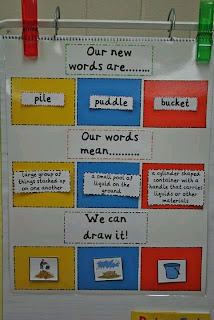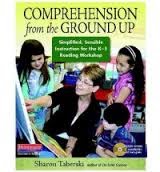
There is a direct, positive relationship between the depth of a learner's vocabulary and the learner's academic success. Children need a rich oral and written vocabulary, so they can understand what they are reading and communicate their ideas to others. Helping students enhance their vocabulary is a top priority, especially because it scaffolds comprehension.
Vocabulary development is not limited to ELA/Communication Arts. It is a part of all content-area instruction. Vocabulary is best taught when learners experience a need to comprehend words and concepts encountered in literature and informational texts as well as in the world around them.
Marzano states that successful vocabulary instruction includes the following research based components:
- Effective vocabulary instruction does not rely on definitions.
- Students must represent their knowledge of words in linguistic and non-linguistic terms.
- Effective vocabulary instruction involves the gradual shaping of word meanings through multiple exposures.
- Teaching word parts enhances students' understanding of terms.
- Different types of words require different types of instruction.
- Students should discuss the terms they are learning over and over again.
- Instruction should focus on terms that have a high probability of enhancing academic success.
Vocabulary with Paint Chip Strips, Tombstones, and Word Thermometers
Paint chip strips are great for generating word lists and working on vocabulary. Record the "worn out words" in the top color box, then have students brainstorm a list of "juicy" words that are synonyms for the worn out word. Record the synonyms on the paint chips.
Here's another idea for paint chip strips. When students listen to reading or read independently, have them keep a post-it handy for recording words that "pop off the
page," or words that make them wonder. Put student dictated words on the paint chip. Depending on the standard/GLE you are teaching, have students look for more words that have the same meaning, write the definition of the word, tell what part of speech it is, look for prefixes and suffixes, etc. Have students tune in to interesting words.
Some teachers like to use tombstones or library pockets to put tired words out of their misery. The teacher and students co-construct the tombstones or tongue depressors by adding synonyms for the tired words. Then, the teacher encourages students to use their newly acquired words to make their writing come to life.
The picture above shows another vocabulary activity we saw in Nixa using different degrees of vocabulary.
Building Vocabulary with Interactive Read Alouds
While working on an interactive read aloud with students, the teacher and/or students pick the vocabulary words they want to focus on throughout the week. The teacher draws the students' attention to these vocabulary words across the curriculum and throughout the week as they reread the book with children. Students draw pictures and define the words in kid lingo. At the end of the week, the new vocabulary gets added to the vocabulary wall. Students can use these words to enhance their writing.


In the intermediate grades, students look for the vocabulary word of the day on the Reading Workshop agenda on the SMARTboard. When the teacher reads aloud to the class at the beginning of the day, the students listen closely for the vocabulary word of the day. Once they hear the word, the teacher stops reading and they discuss the vocabulary word in small teams and then with the whole class. Students can make actions for the word of the day. As the school day continues, the teacher uses the vocabulary word of the day to initiate transitions and more conversations about the vocabulary word. The teacher embeds the word in his/her teaching when it applies to give students multiple encounters with the word throughout the day. Celebrate when the students start using the vocabulary in their speaking and writing and when they point out a vocabulary word in their reading.
Ongoing Vocabulary Work
Co-constructed anchor charts for vocabulary can be ongoing. Students and teachers continue adding to them as they learn more. Anchor charts do not always get made during one mini-lesson.
Teach Vocabulary Across the Curriculum
Students who know the vocabulary excel on assessments.
Teach Vocabulary in Small Doses
When teaching informational text features, genres, the writing traits, or other content, add new vocabulary words to displays as they are taught. It's okay to start with a blank wall or bulletin board. The words will have more meaning to students if they are added to the wall/bulletin board as they are introduced.
Did you know?
- Vocabulary as assessed in first grade predicts more than 30% of grade 11 reading comprehension, much more than reading mechanics as assessed in first grade (Cunningham & Stanovich, 1997).
- Large vocabulary differences are present by the end of grade 2. If teachers can find ways of supporting more rapid vocabulary growth in lower grades, more children will be able to comprehend complex texts in the upper grades (Biemiller, 1999; 2002).
- The research does NOT support - assigning children 20 vocabulary words or doing skill building exercises like drawing a line from the word to the definition, fill-in-the-blank, and write three sentences with each word.
Something to Think About...Quantity of Words Heard
In a typical hour at home, the average child hears:
- Welfare Family - 616 words
- Working Class Family - 1,250 words
- Professional Family - 2,153 words
We must step up and teach vocabulary to help all students be successful and to introduce them to the wonderful world of words.
Resources:
Some teachers have Comprehension from the Ground Up from one of our summer book studies. See pages 202-208 for Sharon Taberski's effective vocabulary practice called "Words Words Words."









































